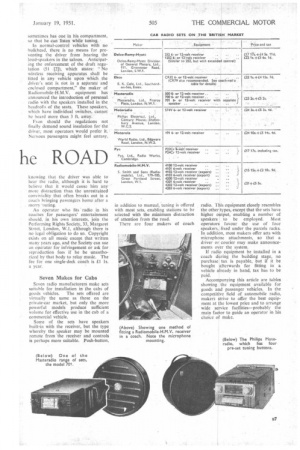RADI O 0 1
Page 40

Page 41

If you've noticed an error in this article please click here to report it so we can fix it.
he ROAD
By Alan Smith
ABOUT three years ago, the chairman of a big food concern paid a visit to one of his company's transport depots. " How do you find your new van?" he asked one of the drivers. Pointing to the radio installed in his chiers Buick, the man replied: "The van's O.K., but I'd like it more if it had one of those in it!"
To-day, this company, T. Wall and Sons. Ltd., has about 100 vans equipped with Radiomobilc-H.M.V. sets, This innovation has been welcomed not only by the drivers, but by the transport executives who are mainly concerned with costs. Drivers proceed more slowly than before, because the noise of fast running drowns reception. Wear on chassis and tyres is thus reduced.
A question that is justifiably asked is whether a driver listening-in to radio is
dangerous. On the face of -it, this would appear to be so, but broadcasts form only a background to the driver's main occupation. Driving is largely a matter of mental reflexes, and most people can drive and carry on a conversation at the same time, just as they can listen to radio and do something else.
In traffic, when perhaps complete attention is required, Wall's drivers are not allowed to use their radio sets. The company has found that its drivers are less fatigued after long runs now that they may listen to a radio, whereas beforehand they had only the wearisome and monotonous accompanying hum of engine and tyres. An incidental point is that by improving the conditions of work of its drivers, the company is able to attract a better class of employee.
'F. Wall and Sons, Ltd., claims to be the first concern to fit radio in its vehicles, but other companies are now following suit. Whilst big undertakings may baulk at the initial, expense involved, smaller operators, particularly furniture removers, are giving the idea a trial.
Passengers Demand Radio
On the passenger-transport side radio is regarded almost as a standard fitment in any coach. Passengers who are anxious not to miss their favourite programmes when going on an outing now often specify a radio-equipped coach when they make the hiring arrangements.
Nuipment made for installation in forward-control coaches is usually arranged so that the driver cannot hear the programmes. The draft Public Service Vehicles (Conditions of Fitness). Regulations, which were proposed nearly two years ago and await ratification.
insist on this system. Speakers are fitted in the saloon, although the driver sometimes has one in his compartment, so that he can listen while tuning.
In normal-contred vehicles with no bulkhead, there is no means for preventing the driver from hearing the loud-speakers in the Saloon. Anticipating the enforcement of the draft regulation (51 [2]), which states: " No wireless receiving apparatus shall be fitted in any vehicle upon which the driver's seat is not in a setiarate and enclosed compartment," the maker of Radiomobile-H.M.V. equipment has announced the introduction of personal. radio with the speakers installed in the headrolls of the seats. These speakers, which have individual switches. cannot be heard more than 3 ft. away.
Even should the regulations not finally demand sound insulation for the driver, most operators Would prefer it. Nervous passengers might feel uneasy, knowing that the driver was able to hear the radio, although it is hard to believe that it would cause him any more distraction than the unrestrained conviviality that often breaks out in a coach bringing passengers home after a merry 'outing.
An operator who fits 'radio in his coaches for passengers' entertainment should, in his own interests, join the Performing Rights Society, 33, Margaret Street, London, W.1, although there is no legal obligation to do so. Copyright exists on all music except that written many years ago, and the Society can sue an operator for infringement or ask for reproduction fees if he be unauthorized by that body to relay music, The fee for one single-deck coach is £1 Is. a year.
Seven Makes for Cabs
Seven radio manufacturers make sets suitable for installation in the cabs of
goods vehicles. The sets offered are virtually the same as those on the private-car market, but only the more powerful models produce sufficient volume for effective use in the cab of a commercial vehicle.
Some of the sets have speakers built-in with the receiver, but the type whereby the speaker may be mounted remote from 'the receiver and controls is perhaps more suitable. Push-button, in addition to manual, tuning is offered with most sets, enabling stations to be selected with the minimum distraction of attention from the road.
There are four makers of coach
radio. This equipment closely resembles the other types, except that the sets have higher output, enabling a number of speakers to be employed. Most operators favour the use of four speakers, fixed under the parcels racks. In addition, most makers offer sets with microphoine attachments, so that a driver on courier may make announcements over the system.
if radio equipment be installed in a coach dining the building stage, no purchase tax is payable, but if it be bought 'afterwards for fitting in a vehicle already in hand, tax has to be paid.
Accompanying this article are tables showing j the equipment available for goods arid passenger vehicles. In the competitive field of automobile radio, makers strive to offer the best equipment at the lowest price and to arrange wide service facilities—probably the main factor to guide an operator in his choice of make.




















































































